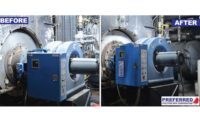Changing laws, advanced technologies, and an aging population are just a few factors driving the cost consciousness of the healthcare industry today. Too often, operational dollars and funding for capital improvements represent the types of investments that do not move the needle quickly enough to affect the bottom line. This limits the design and construction of healthcare facilities to meet short-term needs with little planning toward the future. Further, disruptions within healthcare, and in any critical operation facility, are detrimental and often equate to disruption in revenue.
As profit margins grow slimmer and new regulations are introduced, the justification of newly built facilities is becoming increasingly difficult. For these reasons and more, healthcare organizations are turning to renovation and expansion of their existing facilities, many dating back to the 1960s. Banner Health Boswell Medical Center, for example, is a nonprofit health system based in Phoenix that was originally constructed in 1969. The heart of the Boswell campus is its central utility plant (CUP) that provides cooling, heating, medical gas, and essential electrical infrastructure to the site, producing 5,500kW of essential power, 2,900 tons of chilled water, 400 hp of hot water, and 500 hp of steam.
In the 1970s, an addition was made to the plant and since then, decisions to upgrade or increase facility distribution were made to meet the demands of quick schedules and fewer dollars rather than considering “future” expansion. As a result, the ongoing operation of the hospital has continued without significant changes to the original CUP. Such aging infrastructure is beyond its life expectancy, and in the case of Boswell, a major renovation also is underway in the form of a new emergency department (ED), with too few dollars to spend.
Tight Quarters & Strange Mechanical Room Bedfellows
With most expanding and modernization projects, the mechanical scope of work often involves replacing and relocating boilers, pumps, chillers, and heat exchangers, and then optimizing both the layout for operation and schedule for construction. Each comes with its unique challenges and solutions, including (but not limited) to code compliance and space.
For Boswell, the CUP’s chillers and boilers coexist in three of the same open rooms, a violation of ASHRAE 15. An added challenge to the project was the lack of empty floor space available to stage equipment that would allow for a rearrangement that segregates these systems. In discussion with the owner, it was discovered that the local Authority Having Jurisdiction (AHJ) approved the installation with two modifications to the systems. First, the natural gas feed to the boiler was interlocked with the refrigerant leak detection system. Upon the detection of a refrigerant leak, the fuel source to the boiler would be shut down, eliminating an ignition source. The second modification was to duct the air intake to the burners of the boiler to the exterior of the building. This agreement enabled the project to keep its current arrangement and allowed for the addition of needed chillers for the expansion.
Lack of space created another set of challenges to the overall CUP masterplan, specifically, in creating an empty chair for the rearrangement of equipment. Engineering for this solution required many moving parts. The existing steam generation to hot water system currently in use in the CUP is both extremely inefficient and occupies needed space. Converting this system from steam to boiler hot water provided a practical mechanical solution, and it reduced overall space. Also, electrical equipment currently occupies space needed to add a new chiller. Impact analysis determined that relocating the electrical equipment posed a low-impact risk to the facility and, in turn, provided necessary chiller space.
Electrical Challenges
A review of Boswell’s past projects and a walk-through of the CUP revealed its own set of electrical challenges. First, a lack of separation existed between the normal and emergency equipment. Equipment installed as part of the original construction, and later expanded, was unitized to include normal, emergency, and essential systems. While the installations may have been code-compliant at the time of construction, current editions of NFPA 110 and NFPA 99 have clear requirements for separation of emergency and essential power systems from normal power. To facilitate expansion of the emergency department and future tower, both systems would be needed. Understanding the options and application of code would be a primary challenge.
Understanding the code requirements, and with a desire to engineer using best practices, the team’s approach was to start bringing the CUP into compliance. The emergency power system had been most recently upgraded. The project added a third standby generator to increase system capacity, and configured this new generator with two existing generators to provide an N+1 level of redundancy. To facilitate this configuration, the three generators were connected to new paralleling synchronizing switchgear. Due to the lack of physical space, the switchgear was installed in a non-dedicated space, an apparent violation of NFPA 99.
The project expansion would require the team to install a new breaker and feeder from this switchgear for the essential systems in the emergency department. Building a dedicated space and relocating the switchgear to bring it into compliance was possible, but once again budget constraints quickly dismissed that solution. Instead, a variance was obtained from the AHJ without changing the space.
An additional challenge to this installation was its adjacency in the CUP to an existing domestic hot water system (Figure 1). Revisiting the two governing codes and the application sections, it was discovered that NFPA 110.1.3 states that only for new installations would the separation of space be required, and that existing systems shall not be required to be modified to conform to the requirements of the document. NPFA 110 does allow the exception to code, that where the AHJ determines that nonconformity presents a distinct hazard to life it must be modified, otherwise it is up to the discretion of the AHJ.
NFPA 99.1.3.2 makes a similar statement, with added sections 1.3.2.1 and 1.3.2.2 that address alterations, renovation, or modernization of an existing system. Based on this interpretation of the code sections, the switchgear installation was code compliant. The only exception was related to the adjacency of the water system to the gear. To resolve this issue, coordination with the plumbing engineer resulted in the relocation of the water system, removing the hazard and providing for a future dedicated space.
Resolution for a separate issue involving the unitized switchgear and ATS is being approached with a plan to phase out the equipment and relocate them in a manner compliant to the code. This will require a comprehensive switching plan, which includes the local utility company, and may entail bringing temporary generators onto the site to allow the hospital to continue operation without interruption. This also creates a cost increase to a budget that is already stretched to meet the demands of the customer.
Engineering the solutions to these issues will be a challenge in the design of the expansion and renovation at Boswell. Working toward solutions to the problems through comprehensive review of national and local codes, in conjunction with the AHJ, with sound engineering practices, and through the evaluation of cost implications, will dictate the success of the design and aging infrastructure as a whole.
Preparing for Retrofit Challenges
Four rules of thumb worth following ahead of retrofit work:
-
Understand the history of the systems. Research their evolution from original installation to current state, and know the engineering decisions of the past. This knowledge will help their expansion, particularly if they were made on sound engineering practice.
-
Know the operation of all systems and their relationships. This will help in making recommendations for improvement.
-
Work with engineers across all disciplines to create solutions that work in the best interest of the owner.
-
Revisit the code. Don’t assume that all prior installations were or are code compliant. Sometimes the AHJ overlooks something. Revisiting the application portions of the code can help in shaping your interpretation and application.





